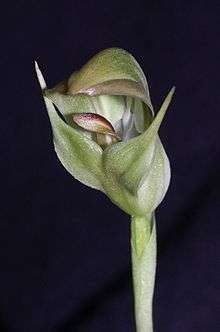Pterostylis curta
Pterostylis curta, commonly known as the blunt greenhood, is a species of orchid found in south-eastern Australia, Lord Howe Island and New Caledonia. It has a rosette of leaves at its base and a single white and green, forward leaning flower with a brown tip and a twisted labellum.
| Blunt greenhood | |
|---|---|
 | |
| Scientific classification | |
| Kingdom: | Plantae |
| Clade: | Tracheophytes |
| Clade: | Angiosperms |
| Clade: | Monocots |
| Order: | Asparagales |
| Family: | Orchidaceae |
| Subfamily: | Orchidoideae |
| Tribe: | Cranichideae |
| Genus: | Pterostylis |
| Species: | P. curta |
| Binomial name | |
| Pterostylis curta | |
Description
Pterostylis curta has a rosette of between two and six egg-shaped to elliptic leaves, each leaf 20–100 mm (0.8–4 in) long and 10–30 mm (0.4–1 in) wide. The leaves are dark green, have a distinct petiole and sometimes a wavy edge. A single white and green flower with a brown tip is borne on a flowering spike 100–300 mm (4–10 in) high, the flower leaning forwards. The flowers are 28–35 mm (1.1–1.4 in) long, 11–15 mm (0.4–0.6 in) wide. The dorsal sepal and petals are fused to form a hood or "galea" over the column. The dorsal sepal and petals are a similar length and end in a blunt tip. There is a wide gap at each side of the flower between the petals and lateral sepals. The lateral sepals are erect, about the same length as the galea, 10–18 mm (0.4–0.7 in) long and there is a broad V-shaped sinus between them. The labellum is 17–22 mm (0.7–0.9 in) long, 4–5 mm (0.16–0.20 in) wide, brown, twisted to one side and just visible above the sinus. Flowering occurs from July to October.[2][3][4][5]
Taxonomy and naming
Pterostylis curta was first described in 1810 by Robert Brown and the description was published in Prodromus Florae Novae Hollandiae et Insulae Van Diemen.[1][6]
Distribution and habitat
The blunt greenhood is widespread and common in Queensland, New South Wales, Victoria and Tasmania, growing in moist places in heath, scrub, woodland and forest.[2][3][4][7] It also occurs on Lord Howe Island and in New Caledonia but is rare in South Australia.[5][8][9]
Use in horticulture
Pterostylis curta is easily grown in pots containing a free-draining, sandy mix. The plants require regular watering during their growing period, to be kept dry during dormancy and to be repotted annually.[10][11]
References
- "Pterostylis curta". APNI. Retrieved 10 May 2017.
- Jones, David L. (2006). A complete guide to native orchids of Australia including the island territories. Frenchs Forest, N.S.W.: New Holland. pp. 303–304. ISBN 978-1877069123.
- Jones, David L. "Pterostylis curta". Royal Botanic Garden Sydney: plantnet. Retrieved 10 May 2017.
- Jeanes, Jeff. "Pterostylis curta". Royal Botanic Gardens Victoria: vicflora. Retrieved 10 May 2017.
- "Pterostylis curta". State Herbarium of South Australia: efloraSA. Retrieved 10 May 2017.
- Brown, Robert (1810). Prodromus florae Novae Hollandiae. London. p. 326. Retrieved 26 April 2017.
- Jones, David L. (1998). "Contributions to Tasmanian Orchidology 7:A Taxonomic Review of Pterostylis in Tasmania". Australian Orchid Research. 3: 142.
- "Greenhood orchid Pterostylis curta". Lord Howe Island Museum. Retrieved 10 May 2017.
- "Pterostylis curta R.Br". Endemia New Caledonia. Retrieved 10 May 2017.
- "Three Australian greenhood orchids for the windowsill: Pterostylis curta, nutans, and Nodding Grace". BotanyBoy Plant Encyclopedia. Retrieved 26 April 2017.
- "Culture of fast-multipying terrestrial orchids". Native Orchid Society of South Australia. Retrieved 10 May 2017.